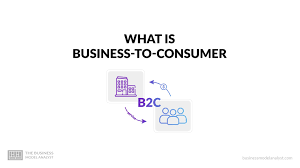1. Introduction to Business-to-Consumer (B2C) Sales
Business-to-consumer (B2C) sales refer to the process of selling products and services directly from a business to individual consumers, who are the end-users of these products and services. Unlike business-to-business (B2B) sales, where businesses sell their products and services to other businesses, B2C sales involve transactions between businesses and individual customers.
B2C sales can be traced back to the late 1970s when Michael Aldrich introduced the concept of selling products to consumers through television. However, it was during the dotcom boom of the late 1990s that B2C sales gained significant traction, particularly with the rise of online retailers that sold products and services directly to consumers through the internet.

2. Understanding Business-to-Consumer (B2C)
To fully grasp the concept of B2C sales, it is important to understand its key characteristics and how it differs from other sales models. B2C sales primarily target consumers, who purchase products and services for personal use rather than for business purposes. The goal of B2C marketing campaigns is to capture the attention of consumers and elicit an emotional response, ultimately driving them to make a purchase.
In contrast, B2B sales involve selling products and services to other businesses, where the purchasing process can be more complex and often requires approval from multiple stakeholders. B2B marketing focuses on demonstrating the value and benefits of a product or service to the business as a whole, rather than appealing to individual emotions.
3. The Rise of B2C in the Digital World
The advent of the internet revolutionized the way businesses interacted with consumers, opening up new avenues for B2C sales. Traditional brick-and-mortar retailers faced challenges from online retailers who promised to sell directly to consumers, cutting out the middleman and offering lower prices.
During the dotcom boom, many businesses rushed to establish an online presence. However, the subsequent dotcom bust led to the closure of numerous online retailers. Despite this setback, certain B2C leaders, such as Amazon and Priceline, not only survived but thrived, paving the way for further disruption in the industry.
B2C Storefronts vs. Internet Retailers
Traditionally, manufacturers would sell their products to retailers who would then mark up the price and sell them to consumers. However, the rise of the internet enabled businesses to sell directly to consumers, bypassing the need for physical storefronts and eliminating the additional costs associated with middlemen.
This shift to online retailing posed a significant threat to traditional retailers, who relied on adding a markup to the price. As a result, many brick-and-mortar retailers were forced to shut their doors and adapt to the changing landscape.
Decades after the dotcom revolution, online B2C companies with a strong web presence continue to dominate over their traditional counterparts. Companies like Amazon, Priceline, and eBay have not only survived but have become industry disruptors, reshaping the way consumers shop for products and services.
4. The Five Types of Online B2C Business Models
Online B2C sales can be categorized into five distinct models, each with its own unique approach to selling products and services to consumers. These models encompass a wide range of strategies, from direct selling to community-based platforms. Let’s explore each model in detail:
4.1 Direct Sellers
The direct seller model is the most common and straightforward B2C business model. In this model, online retailers, including manufacturers, small businesses, and department stores, sell their products directly to consumers through their websites. Customers can browse through various products, make a selection, and complete their purchase online.
One notable example of a direct seller is Shopify, a platform that enables small retailers to sell their products online and reach a broader audience. With the rise of e-commerce, direct sellers have gained significant popularity, offering consumers a convenient and hassle-free shopping experience.
4.2 Online Intermediaries
Online intermediaries act as intermediaries or go-betweens, connecting buyers and sellers without actually owning the products or services themselves. These platforms facilitate transactions between consumers and businesses, providing a convenient marketplace for buyers and sellers to interact.
Well-known examples of online intermediaries include Expedia, trivago, and Etsy. Expedia, for instance, connects travelers with various airlines, hotels, and car rental companies, making it easier for consumers to find the best deals and make reservations.
4.3 Advertising-Based B2C
In the advertising-based B2C model, companies use free content to attract visitors to their websites. These visitors are then exposed to digital or online advertisements, generating revenue for the company. Large volumes of web traffic are leveraged to sell advertising space, promoting various goods and services.
A prime example of this model is HuffPost, a high-traffic media site that combines advertising with its native content. By attracting a substantial user base, HuffPost is able to generate revenue through advertising partnerships.
4.4 Community-Based
Community-based B2C platforms revolve around the creation of online communities based on shared interests or demographics. These platforms bring together like-minded individuals and provide businesses with opportunities to promote their products directly to consumers.
Facebook, formerly known as Meta, is a prime example of a community-based platform. By gathering a large user base, Facebook offers businesses the ability to target ads based on users’ demographics and geographical location, ensuring that their products reach the desired audience.
4.5 Fee-Based
Fee-based B2C models involve charging consumers a fee in exchange for accessing content or services. These models often provide a combination of free and premium content, enticing users to upgrade to a paid subscription for access to exclusive features or a broader range of content.
Netflix, a popular streaming service, operates on a fee-based model. While Netflix offers some free content as a teaser, most of its content is accessible only to paid subscribers. Similarly, newspapers like The New York Times often employ a fee-based model, providing limited free articles and requiring a subscription for full access.
5. B2C Companies and the Mobile Market
In recent years, the mobile market has become a significant focus for B2C companies. With the proliferation of smartphones and the increasing popularity of mobile apps, businesses have shifted their attention to mobile users and capitalized on this technology.
During the early 2010s, B2C companies raced to develop mobile apps, much like they did with websites in the past. The success of B2C sales relies on continuous adaptation to consumers’ changing preferences, trends, and desires. Mobile apps provide businesses with a direct channel to engage with consumers, offering personalized experiences and seamless transactions.
The mobile market presents immense opportunities for B2C companies, as mobile app usage continues to grow year-over-year. By harnessing the power of mobile technology, businesses can reach consumers anytime, anywhere, and provide them with a convenient and seamless shopping experience.
6. B2C vs. Business-to-Business (B2B) Sales
While B2C sales focus on selling products directly to individual consumers, B2B sales involve selling products and services to other businesses. These two sales models differ in several key aspects, including the target audience, marketing strategies, and purchasing process.
In B2C sales, consumers purchase products for personal use, often driven by emotional factors such as desire, convenience, or necessity. B2C marketing campaigns aim to capture the attention and emotions of individual consumers, persuading them to make a purchase.
On the other hand, B2B sales target businesses that purchase products or services to support their own operations. The purchasing process in B2B sales is often more complex, involving multiple stakeholders and requiring extensive negotiations. B2B marketing focuses on demonstrating the value and benefits of a product or service to the business as a whole, rather than appealing to individual emotions.
Additionally, pricing structures in B2C and B2B sales differ significantly. In B2C sales, consumers often pay the same price for a product or service. However, in B2B sales, pricing is often negotiated, taking into account factors such as volume discounts, long-term contracts, and payment terms.
7. Key Characteristics of B2C Sales
To effectively engage in B2C sales, businesses must understand the key characteristics that define this sales model. By acknowledging these characteristics, businesses can tailor their strategies to meet the needs and expectations of individual consumers. Here are some of the key characteristics of B2C sales:
7.1 Consumer-Centric Approach
B2C sales revolve around the needs and preferences of individual consumers. To succeed in this model, businesses must adopt a consumer-centric approach, understanding consumer behavior, preferences, and purchasing patterns. By gaining insights into consumer wants and needs, businesses can develop targeted marketing campaigns and deliver personalized experiences.
7.2 Emotional Appeal
Emotions play a crucial role in B2C sales. Consumers are often driven by desires, aspirations, and emotions when making purchasing decisions. Successful B2C marketing campaigns tap into these emotions, creating compelling narratives and experiences that resonate with consumers on a personal level.
7.3 Convenience and Accessibility
In the fast-paced digital world, consumers value convenience and accessibility. B2C businesses must prioritize providing seamless, user-friendly experiences across various channels, including websites, mobile apps, and social media platforms. The ability to browse, compare, and purchase products with ease is essential in capturing the attention and loyalty of consumers.
7.4 Branding and Differentiation
In a crowded marketplace, building a strong brand and differentiating from competitors is vital for B2C businesses. Branding encompasses visual identity, messaging, and the overall perception consumers have of a company. By crafting a unique brand image and establishing a positive reputation, businesses can stand out and attract loyal customers.
7.5 Customer Service and Relationship Building
Maintaining good customer relationships is crucial in B2C sales. Businesses must prioritize exceptional customer service, addressing inquiries, resolving issues, and ensuring customer satisfaction. Building strong relationships with customers increases the likelihood of repeat purchases, positive word-of-mouth, and long-term loyalty.
8. Best Practices for Successful B2C Sales
To excel in the competitive B2C landscape, businesses must adopt best practices that enhance their sales strategies and customer experiences. While each business is unique, incorporating the following practices can significantly improve B2C sales:
8.1 Comprehensive Market Research
Thorough market research is essential in understanding consumer preferences, market trends, and competitive landscapes. By conducting comprehensive research, businesses can identify target audiences, segment markets, and develop strategies that align with consumer needs.
8.2 Personalized Marketing Campaigns
Personalization is key in B2C marketing. By leveraging consumer data and insights, businesses can create tailored marketing campaigns that resonate with individual consumers. Personalization can involve targeted emails, customized recommendations, and personalized content that speaks directly to consumer interests and preferences.
8.3 Omni-Channel Presence
Consumers expect a seamless experience across multiple touchpoints. B2C businesses must establish an omni-channel presence, ensuring consistency and continuity across various channels such as websites, mobile apps, social media platforms, and physical stores if applicable. A seamless omni-channel experience increases customer satisfaction and drives sales.
8.4 Streamlined Checkout Process
A complicated and time-consuming checkout process can lead to cart abandonment and lost sales. B2C businesses should prioritize a streamlined and user-friendly checkout process, minimizing the number of steps required to complete a purchase. Offering various payment options and ensuring secure transactions is also essential in building consumer trust.
8.5 Post-Purchase Engagement
The customer journey does not end after a purchase is made. B2C businesses should focus on post-purchase engagement, following up with customers, requesting feedback, and providing relevant after-sales support. Establishing ongoing communication and building relationships with customers increases the likelihood of repeat purchases and customer loyalty.
9. Examples of Successful B2C Companies
Several B2C companies have achieved remarkable success by effectively implementing their sales strategies and catering to the needs of consumers. Let’s explore some notable examples of successful B2C companies:
9.1 Amazon
Amazon, founded by Jeff Bezos in 1994, started as an online bookstore but quickly expanded its offerings to become a global e-commerce giant. With a vast product selection, competitive prices, and a user-friendly shopping experience, Amazon has revolutionized the way consumers shop online. The company’s focus on customer-centricity, fast shipping, and personalized recommendations has led to its immense success.
9.2 Shopify
Shopify, founded in 2006, provides a platform for small businesses to sell their products online. By offering an intuitive and feature-rich e-commerce solution, Shopify enables businesses to establish their online presence and reach a broader audience. The platform’s user-friendly interface, customizable themes, and robust back-end functionalities have made it a preferred choice for entrepreneurs and small retailers.
9.3 Netflix
Netflix, founded in 1997, is a leading provider of streaming entertainment. The company disrupted the traditional video rental market by offering a subscription-based model that allows consumers to access a vast library of movies and TV shows. With its original content, personalized recommendations, and user-friendly interface, Netflix has become a dominant force in the entertainment industry.
9.4 Airbnb
Airbnb, founded in 2008, revolutionized the travel and hospitality industry by connecting travelers with unique accommodations offered by individual hosts. By providing an alternative to traditional hotels, Airbnb offers consumers a more personalized and authentic travel experience. Its platform enables hosts to list their properties, while travelers can book accommodations based on their preferences and budget.
10. Future Trends in B2C Sales
As technology continues to advance and consumer preferences evolve, B2C sales will undoubtedly undergo further transformations. Several trends are shaping the future of B2C sales, presenting both opportunities and challenges for businesses. Here are some key trends to watch:
10.1 Artificial Intelligence (AI) and Machine Learning
AI and machine learning technologies are increasingly being integrated into B2C sales strategies. These technologies enable businesses to analyze vast amounts of consumer data, personalize marketing campaigns, and provide more accurate product recommendations. AI-powered chatbots and virtual assistants also enhance customer service, providing instant support and improving overall customer experiences.
10.2 Voice Commerce
The rise of voice-activated smart devices, such as Amazon Echo and Google Home, has given birth to the concept of voice commerce. Consumers can now make purchases simply by using voice commands. B2C businesses should consider optimizing their online platforms for voice search and exploring voice commerce as a new sales channel.
10.3 Social Commerce
Social media platforms have become influential in driving B2C sales. Social commerce involves selling products directly on social media platforms, leveraging the vast user base and targeting capabilities these platforms offer. B2C businesses should harness the power of social media to engage with consumers, showcase products, and facilitate seamless purchasing experiences.
10.4 Augmented Reality (AR) and Virtual Reality (VR)
AR and VR technologies have the potential to revolutionize the way consumers shop for products. B2C businesses can leverage these technologies to provide immersive and interactive experiences, allowing consumers to virtually try on clothes, visualize furniture in their homes, or explore destinations before making a purchase. The integration of AR and VR in B2C sales can enhance customer engagement and reduce product return rates.
11. Conclusion
In conclusion, business-to-consumer (B2C) sales play a crucial role in the global marketplace. B2C companies strive to meet the needs and desires of individual consumers, utilizing various sales models and strategies to drive engagement and sales. By understanding the key characteristics of B2C sales, adopting best practices, and staying abreast of emerging trends, businesses can succeed in this highly competitive landscape. As technology continues to evolve and consumer preferences change, B2C sales will undoubtedly continue to evolve, presenting new opportunities and challenges for businesses.




No comments! Be the first commenter?